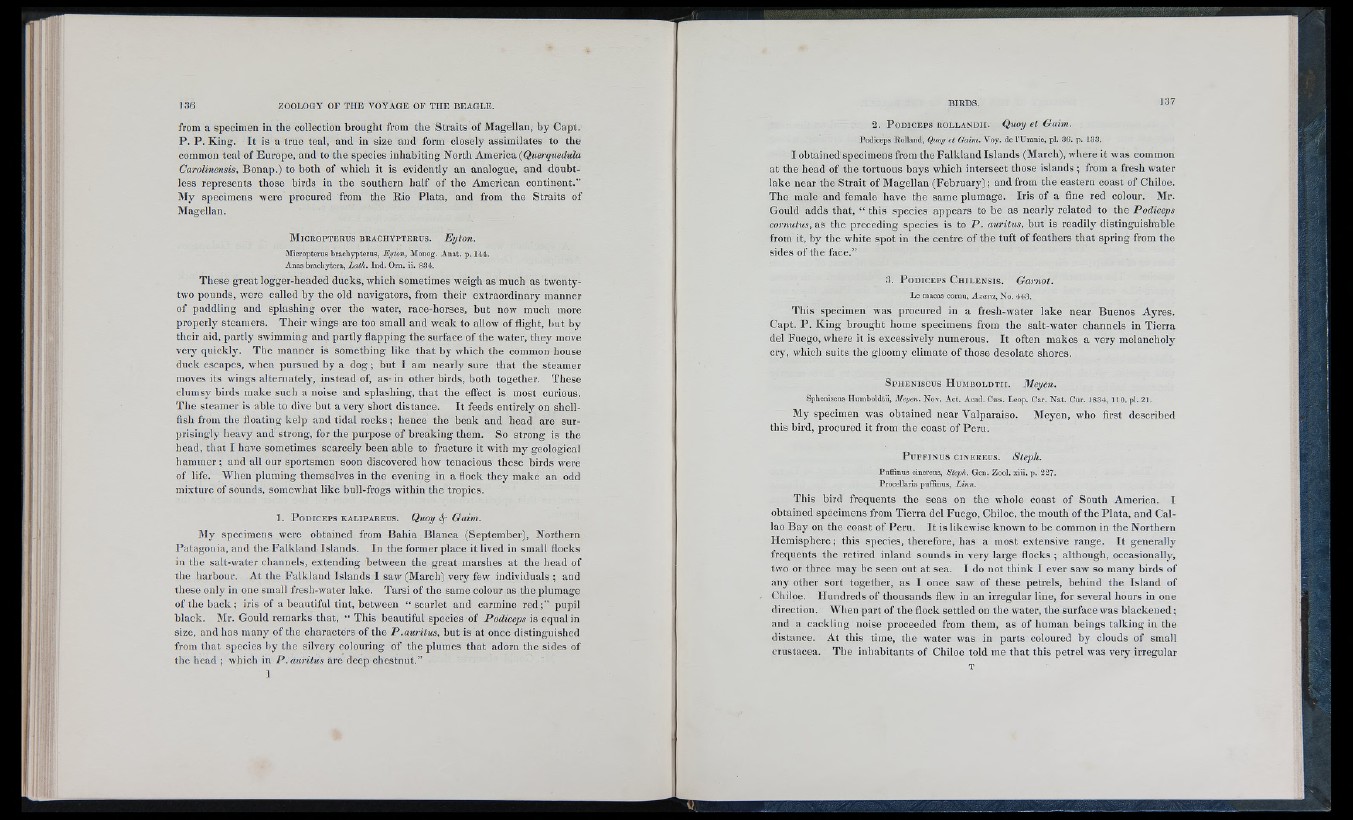
from a specimen in the collection brought from the Straits of Magellan, by Capt.
P. P. King. It is a true teal, and in size and form closely assimilates to the
common teal of Europe, and to the species inhabiting North Amexiczi {Querquedula
Carolmensis, Bonap.) to both of which it is evidently an analogue, and doubtless
represents those birds in the southern half of the American continent.”
My specimens were procured from the Rio Plata, and from the Straits of
Magellan.
M ic r o p t e r u s b r a c h y p t e r u s . Eyton.
Micropterus brachypterus, Eyton, Monog. Anat. p. 144.
Alias brachytera, Lath. Ind. Orn. ii. 834.
These great logger-headed ducks, which sometimes weigh as much as twenty-
two pounds, were called by the old navigators, from their extraordinary manner
of paddling and splashing over the water, race-horses, but now much more
properly steamers. Their wings are too small and weak to allow of flight, but by
their aid, partly swimming and partly flapping the surface of the water, they move
very quickly. The manner is something like that by which the common house
duck escapes, when pursued by a dog ; but I am nearly sure that the steamer
moves its wings alternately, instead of, as-in other birds, both together. These
clumsy birds make such a noise and splashing, that the effect is most curious.
The steamer is able to dive but a very short distance. It feeds entirely on shellfish
from the floating kelp and tidal rocks ; hence the beak and head are surprisingly
heavy and strong, for the purpose of breaking them. So strong is the
head, that I have sometimes scarcely been able to fracture it with my geological
hammer; and all our sportsmen soon discovered how tenacious these birds were
of life. When pluming themselves in the evening in a flock they make an odd
mixture of sounds, somewhat like bull-frogs within the tropics.
1 . P o d ic e p s k a l i p a r e u s . Quoy ^ Gaim.
My specimens were obtained from Bahia Blanca (September), Northern
Patagonia, and the Falkland Islands. In the former place it lived in small flocks
in the salt-water channels, extending between the great marshes at the head of
the harbour. At the Falkland Islands I saw (March) very few individuals ; and
tliese only iu one small fresh-water lake. Tarsi of the same colour as the plumage
of the back; iris of a beautiful tint, between “ scarlet and carmine red;” pupil
black. IMr. Gould remarks that, “ This beautiful species of Podiceps is equal in
size, and has many of the characters of the P.auritus, but is at once distinguished
from that species by the silvery colouring of the plumes that adorn the sides of
the head ; which in P.auritus are deep chestnut.”
1
2 . P o d i c e p s r o llan d ii. Quoy ei Gaim.
Podiceps Rolland, Quoy et Gaim. Voy. de I’Uranie, pl. 36. p. 133.
I obtained specimens from the Falkland Islands (March), where it was common
at the head of the tortuous bays which intersect those islands ; from a fresh water
lake near the Strait of Magellan (February); and from the eastern coast of Chiloe.
The male and female have the same plumage. Iris of a fine red colour. Mr.
Gould adds that, “ this species appears to be as nearly related to the Podiceps
cornutus, as the preceding species is to P . auritus, but is readily distinguishable
from it, by the white spot in the centre of the tuft of feathers that spring from the
sides of the face.”
3 . P o d i c e p s C h i l e n s i s . Garnot.
Le macas comu, Azara, No. 443.
This specimen was procured in a fresh-w'ater lake near Buenos Ayres.
Capt. P. King brought home specimens from the salt-water channels in Tierra
del Fuego, where it is excessively numerous. It often makes a very melancholy
cry, which suits the gloomy climate of those desolate shores.
S p h e n i s c u s H u m b o l d t i i . 3leyen.
Sphenipcus Humboldtii, Meyen. Nov. Act. Acad. Coes. Leop. Car. Nat. Cur. 1834, 110. pl. 21.
My specimen was obtained near Valparaiso. Meyen, who first described
this bird, procured it from tbe coast of Peru.
PUPFINUS CINEREDS. Steph.
Puffinus clnerous, Steph. Gen. Zool. xiii. p. 227.
Procellaria puffinus, Linn.
Tliis bird frequents the seas on the whole coast of South America. I
obtained specimens from Tierra del Fuego, Chiloe, the mouth of the Plata, and Callao
Bay on the coast of Peru. It is likewise known to be common in the Northern
Hemisphere ; this species, therefore, has a most extensive range. It generally
frequents the retired inland sounds in very large flocks ; although, occasionally,
two or three may be seen out at sea. I do not think I ever saw so many birds of
any other sort together, as I once saw of these petrels, behind the Island of
Chiloe. Hundreds of thousands flew' in an irregular line, for several hours in one
direction. When part of the flock settled on the w^ater, the surface was blackened ;
and a cackling noise proceeded from them, as of human beings talking in the
distance. At this time, the water was in parts coloured by clouds of small
Crustacea. The inhabitants of Chiloe told me that this petrel was very irregular